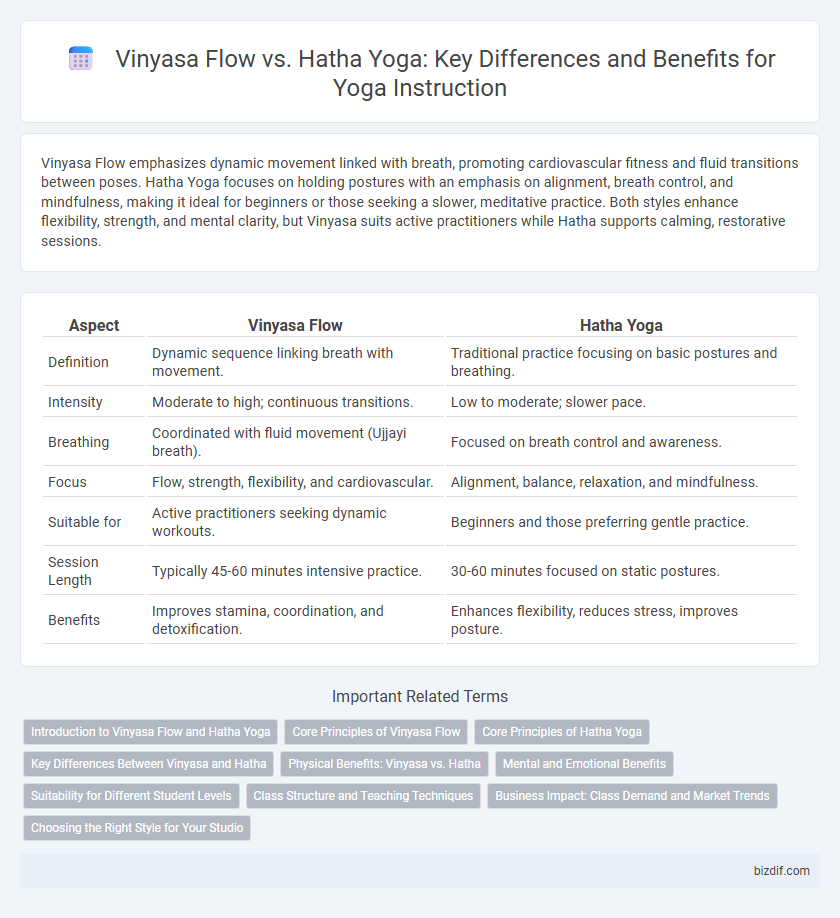Vinyasa Flow emphasizes dynamic movement linked with breath, promoting cardiovascular fitness and fluid transitions between poses. Hatha Yoga focuses on holding postures with an emphasis on alignment, breath control, and mindfulness, making it ideal for beginners or those seeking a slower, meditative practice. Both styles enhance flexibility, strength, and mental clarity, but Vinyasa suits active practitioners while Hatha supports calming, restorative sessions.
Table of Comparison
| Aspect | Vinyasa Flow | Hatha Yoga |
|---|---|---|
| Definition | Dynamic sequence linking breath with movement. | Traditional practice focusing on basic postures and breathing. |
| Intensity | Moderate to high; continuous transitions. | Low to moderate; slower pace. |
| Breathing | Coordinated with fluid movement (Ujjayi breath). | Focused on breath control and awareness. |
| Focus | Flow, strength, flexibility, and cardiovascular. | Alignment, balance, relaxation, and mindfulness. |
| Suitable for | Active practitioners seeking dynamic workouts. | Beginners and those preferring gentle practice. |
| Session Length | Typically 45-60 minutes intensive practice. | 30-60 minutes focused on static postures. |
| Benefits | Improves stamina, coordination, and detoxification. | Enhances flexibility, reduces stress, improves posture. |
Introduction to Vinyasa Flow and Hatha Yoga
Vinyasa Flow is a dynamic yoga style emphasizing fluid transitions between poses synchronized with breath, promoting strength, flexibility, and cardiovascular endurance. Hatha Yoga prioritizes static postures held with mindful breath awareness, fostering alignment, balance, and relaxation for beginners and practitioners seeking slower-paced practice. Both styles serve distinct needs, with Vinyasa enhancing physical conditioning and Hatha building foundational stability and mental calm.
Core Principles of Vinyasa Flow
Vinyasa Flow emphasizes dynamic movement synchronized with breath, creating a fluid sequence that enhances cardiovascular fitness and flexibility. Core principles include continuous transitions, mindful breath control (ujjayi breathing), and rhythm that link poses into a cohesive flow. This practice contrasts with Hatha Yoga's slower pace and static holds, focusing more on alignment and individual postures.
Core Principles of Hatha Yoga
Hatha Yoga emphasizes balance and alignment through steady postures, breath control (pranayama), and mindful meditation, focusing on harmonizing body and mind. Its core principles include cultivating physical strength, flexibility, and mental clarity by holding poses longer for deep internal awareness. Unlike Vinyasa Flow's dynamic sequences, Hatha promotes slow, deliberate movements that foster stability and inner calm.
Key Differences Between Vinyasa and Hatha
Vinyasa Flow emphasizes continuous movement synchronized with breath, creating a dynamic and cardiovascular workout that enhances strength and flexibility. Hatha Yoga focuses on static poses held for longer durations, promoting alignment, balance, and mindfulness through controlled breathing. The primary difference lies in Vinyasa's fluid transitions and higher intensity compared to Hatha's deliberate pace and emphasis on foundational posture.
Physical Benefits: Vinyasa vs. Hatha
Vinyasa Yoga emphasizes dynamic movement and breath synchronization, promoting cardiovascular endurance, muscle strength, and flexibility through continuous, flowing sequences. Hatha Yoga focuses on holding static postures with controlled breathing, enhancing balance, joint mobility, and muscular endurance by allowing deep muscular engagement and alignment awareness. Both practices improve physical health but target different aspects of fitness: Vinyasa boosts stamina and agility, while Hatha cultivates stability and mindfulness in body mechanics.
Mental and Emotional Benefits
Vinyasa Flow yoga enhances mental clarity and emotional balance through its dynamic sequences that foster mindfulness and stress release. Hatha yoga promotes deep relaxation and emotional stability by emphasizing slow, deliberate postures that cultivate breath awareness and inner calm. Both styles improve mental resilience and reduce anxiety, but Vinyasa Flow energizes the mind while Hatha nurtures tranquility.
Suitability for Different Student Levels
Vinyasa Flow offers dynamic sequences ideal for intermediate to advanced practitioners seeking a vigorous and fluid practice that enhances strength and flexibility. Hatha Yoga provides a slower, more deliberate pace suitable for beginners and those requiring gentle alignment and breath awareness. Both styles adapt well to varying skill levels, but Hatha Yoga excels in foundational learning while Vinyasa challenges stamina and coordination.
Class Structure and Teaching Techniques
Vinyasa Flow classes emphasize dynamic sequencing with continuous movement linked to breath, promoting cardiovascular engagement and fluid transitions between poses. Hatha Yoga sessions prioritize static postures held for longer durations, focusing on alignment, breath control, and foundational techniques suitable for beginners. Teaching techniques in Vinyasa often involve rhythmic cues and creative variations, whereas Hatha instruction centers on detailed posture breakdowns and mindfulness practices.
Business Impact: Class Demand and Market Trends
Vinyasa Flow yoga's dynamic sequences attract a younger, fitness-focused demographic, resulting in higher class demand and increased revenue potential for studios in urban markets. Hatha Yoga, with its slower pace and emphasis on alignment, appeals to beginners and wellness seekers, maintaining steady class attendance in traditional and holistic health settings. Market trends indicate a growing preference for Vinyasa Flow in competitive metropolitan areas, while Hatha sustains longevity in established yoga communities.
Choosing the Right Style for Your Studio
Vinyasa Flow emphasizes dynamic, continuous movement synchronized with breath, making it ideal for students seeking a vigorous, cardiovascular-focused practice. Hatha Yoga offers a slower, more deliberate approach to postures and alignment, suitable for beginners or those prioritizing mindfulness and physical stability. Selecting the right style for your studio depends on your target audience's fitness levels, experience, and desired outcomes, balancing energy flow with accessibility.
Vinyasa Flow vs Hatha Yoga Infographic

 bizdif.com
bizdif.com